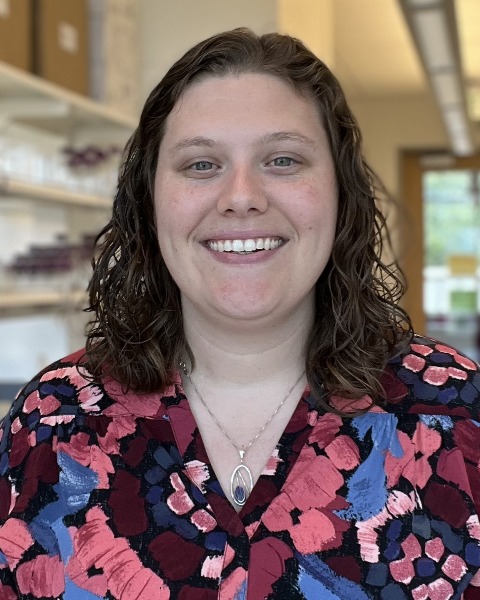Biomechanics
Mechanics of the Lungs, Gut, and Blood Components
Connecting the (Black) Dots: Platelet Force Generation and Cytoskeletal Structure
Saturday, October 26, 2024
3:00 PM - 3:15 PM EST
Location: Room 344

Molly Y. Mollica, PhD (she/her/hers)
Assistant Professor
University of Maryland, Baltimore County, United States
Presenting Author(s)
Introduction: One in four deaths worldwide is related to bleeding or thrombosis and platelets are major regulators of these processes. During hemostasis and thrombosis, platelets are activated by a combination of biochemical (e.g., thrombin) and biophysical (e.g., shear) cues. Upon activation, platelets dramatically and rapidly change shape, bind to a surface, aggregate, spread, and contract. Platelet contraction (i.e., force generation) is driven by the actin cytoskeleton and is important supporting adhesion, expelling hemolytic enzymes, and compacting a clot. Platelets from healthy donors can generate a remarkable amount of force – as much as 150 to 600 nN from a single platelet. Despite their small size, platelets are capable of more force than other cell types, including larger cells with major contractile functions such as cardiomyocytes that are 10-20X larger in area, but produce lower maximum force per cell around 140-190 nN. When measured on a bulk (i.e., millions of platelets) scale, impairment of platelet forces is associated with bleeding, while increased platelet forces are associated with some diseases of thrombosis. Despite this indication that platelet force generation has biological significance, existing bulk methodologies are limited in sensitivity and applicability. Measuring forces on a single-platelet scale is attractive due to recent demonstration of the ability to detect bleeding propensity more sensitively than all existing clinical tests and the ability decouple platelet function from platelet count. However, existing techniques to measure and understand single-platelet forces have been hampered by low-yield, inability to co-measure immunofluorescent cell markers, and/or arbitrary restriction of cell spreading.
Materials and
Methods: To address these limitations, we developed a technique (dubbed “black dots”) that enables high-yield co-measurement of cellular forces and immunofluorescent-labeled cell markers in a single image without constraining cell spreading. Black dots are created by microcontact printing a fluorescent bovine serum albumin in a pattern on a polydimethylsiloxane substrate of controllable stiffness. When platelets are seeded onto the black dots, they spread and contract, displacing the pattern underneath the platelet (Figure 1A). The deformations of the dots are visualized via fluorescence microscopy and Fourier Transform Traction Cytometry is used to determine a single platelet’s traction forces (Figure 1B-E). As a result of the high yield of data obtainable with black dots, we were able to use multivariate mixed effects modeling, K-means clustering, and machine learning to elucidate complex relationships between platelet activation, structure, and force generation.
Results, Conclusions, and Discussions: After measuring over 1,000 single-platelet forces, we find platelets that exert more force have more spread area, are more circular, and have more uniformly distributed F-actin filaments. Further, we applied a multivariate mixed effects model and found that there are complex relationships between spread area, circularity, F-actin dispersion, including cooperative effects that significantly associate with platelet traction forces (Figure 1F).
In addition to biophysical factors, we investigated platelet cytoskeletal structure and function in response to activation with distinct blood proteins fibrinogen and von Willebrand Factor (VWF) that play unique roles in hemostasis. We identified distinct F-actin patterns induced by these protein coatings and found that these morphologies were identifiable into three classifications via machine learning: solid, nodular, and hollow. We observed that traction forces for platelets were significantly higher on VWF than on fibrinogen coatings and these forces varied by F-actin pattern (Figure 1G). In addition, we analyzed the F-actin orientation in platelets and noted that their filaments were more circumferential when on fibrinogen coatings and having a hollow F-actin pattern, while they were more radial on VWF and having a solid F-actin pattern. Finally, we noted that subcellular localization of traction forces corresponded to protein coating and F-actin pattern: VWF-bound, solid platelets had higher forces at their central region while fibrinogen-bound, hollow platelets had higher forces at their periphery.
Finally, we adapted black dots to be compatible with mouse platelets, which are smaller and produce less force than human platelets. To define the role of Filamin A, an actin crosslinking protein, in regulating actomyosin contraction in platelets, we studied platelets derived from mice with a megakaryocyte/platelet-specific deletion of Filamin A. We found that platelets without Filamin A have defects in stress fiber formation and significantly reduced average platelet force. Surprisingly, we found that despite impaired average platelet forces, some individual platelets without Filamin A were able to compensate and produce forces comparable to the strongest platelets in the control. Biochemical studies revealed that Filamin A is a critical regulator of thrombin-induced MLC phosphorylation via ROCK and protein kinase C pathways.
These results have implications in hemostasis, bleeding, and thrombosis.
Acknowledgements (Optional): This work is a synthesis of published and unpublished work. I would like to acknowledge those that contributed to this work including Kevin M. Beussman, Adithan Kandasamy, Lesley Martínez Rodríguez, Francisco R. Morales, Junmei Chen, Krithika Manohar, Juan Carlos del Álamo, José A. López, Wendy E. Thomas, Nathan J. Sniadecki, Andrea Leonard, Jeffrey Miles, John Hocter, Zizhen Song, Moritz Stolla, Sangyoon J. Han, Ashley Emery, Felix Hong, Hugh Kim, Matthew Bryman, Chris Kelley, and Adah Harding.
